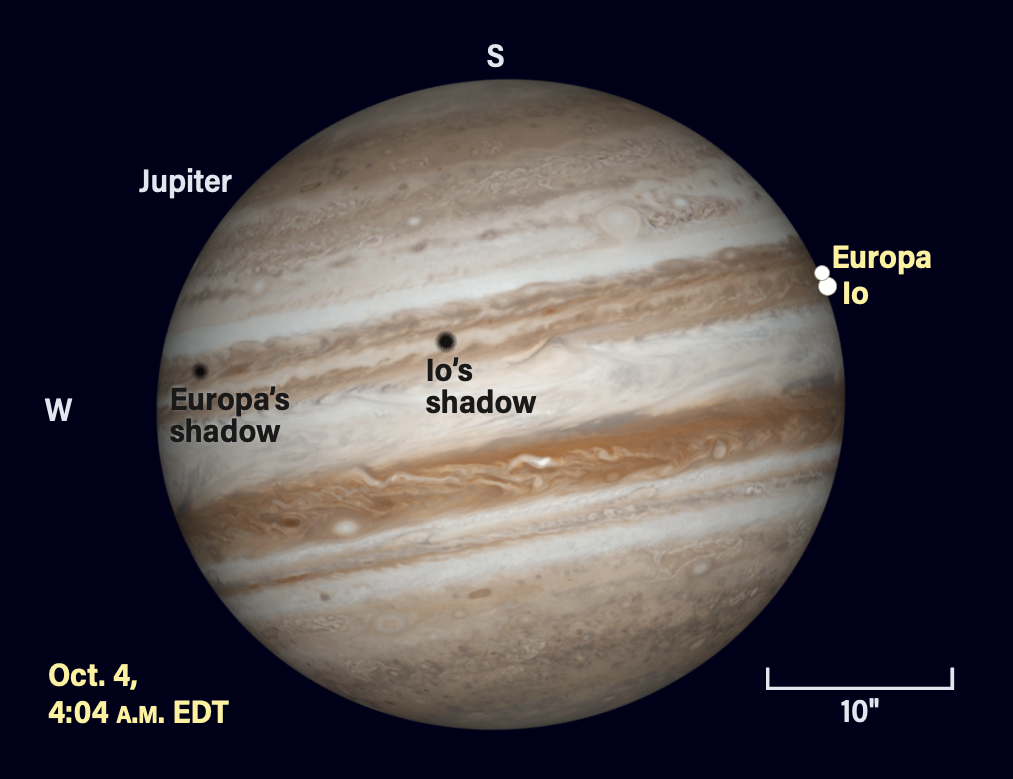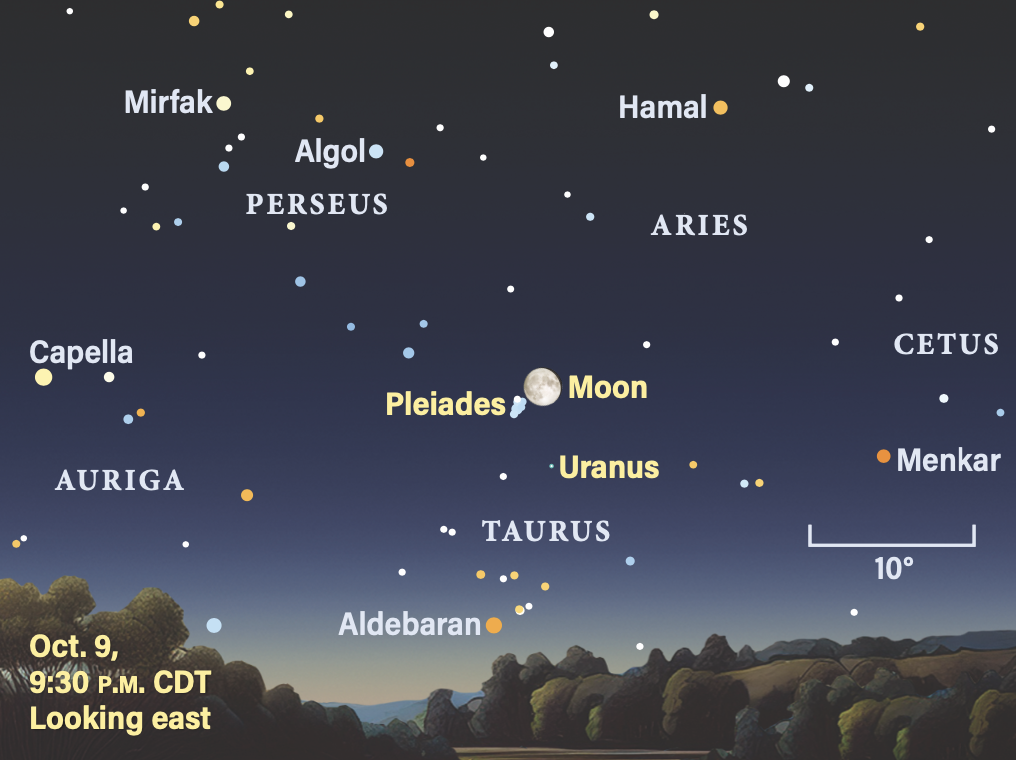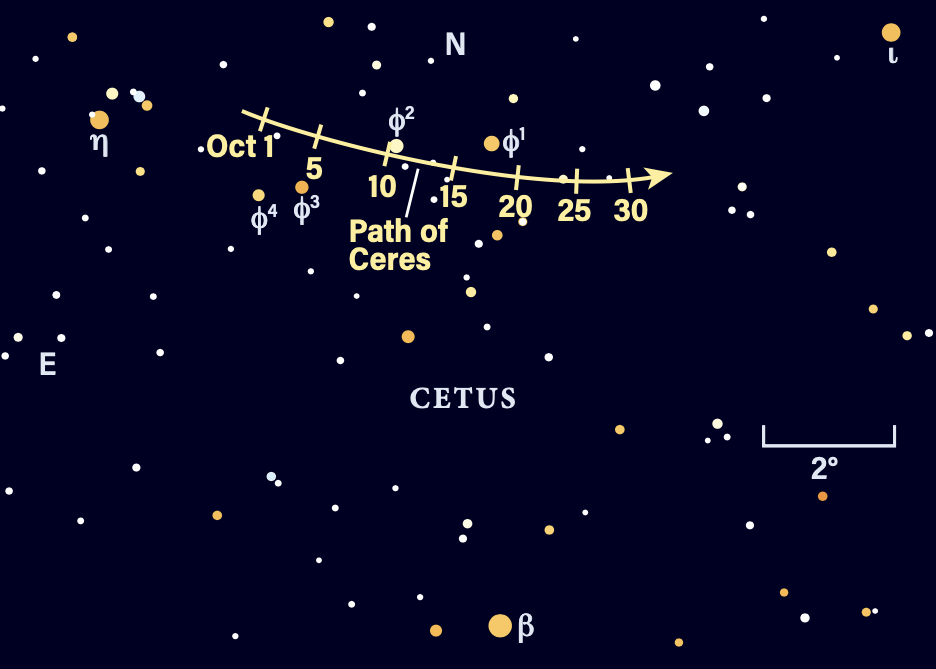Special to CosmicTribune.com, October 6, 2025
Excerpts from weekly Astronomy.com report.
Friday, October 3
There’s a new potential supernova candidate in a spiral galaxy located in Ursa Major, visible overnight for U.S. observers. If you’ve got an imaging scope or an astrophotography setup on a larger optical instrument, you may want to give it a try.
The supernova candidate, currently cataloged as AT 2025yyn, was spotted Sept 30 by the Zwicky Transient Facility in California. It’s located in the face-on spiral galaxy UGC 5302, which may not be in your go-to computer’s database. You can find it at Right Ascension 09h54m22s and Declination 68°19’57”.
By 5 A.M. local daylight time, Comet Lemmon is some 30° high in the east. Definitely give this one a try — it should be much more rewarding!
Sunrise: 6:59 A.M.
Sunset: 6:38 P.M.
Moonrise: 5:00 P.M.
Moonset: 2:40 A.M.
Moon Phase: Waxing gibbous (85%)
*Times for sunrise, sunset, moonrise, and moonset are given in local time from 40° N 90° W. The Moon’s illumination is given at 12 P.M. local time from the same location.
 Io and Europa overlap (with smaller Europa appearing in front) as the two moons begin a transit of Jupiter on Oct.4. Ganymede lies east of Jupiter and Callisto lies to the west, outside the field of view shown here. Credit: Astronomy: Roen Kelly
Io and Europa overlap (with smaller Europa appearing in front) as the two moons begin a transit of Jupiter on Oct.4. Ganymede lies east of Jupiter and Callisto lies to the west, outside the field of view shown here. Credit: Astronomy: Roen KellySaturday, October 4
Jupiter’s Galilean moons often transit the planet’s disk one at a time — tonight, however, Io and Europa cross the disk together. The two moons even appear to partially overlap as their transits begin early this morning at 4:04 a.m. EDT, with smaller Europa passing in front of larger Io.
You’ll spot bright Jupiter high in the east around this time, to the lower right of Castor and Pollux in Gemini (the planet outshines the two stars). Make sure to get your telescope out early — around 3:30 A.M. EDT, Io and Europa are approaching Jupiter from the east, but their shadows are already crossing the disk. Europa’s shadow is nearest the western limb, while Io’s is closer to the eastern limb (and the two moons). The moons’ transit begins at 4:04 A.M. EDT, with Europa’s shadow slipping off the opposite limb 13 minutes later.
Keep watching as Io quickly pulls ahead of Europa; the volcanic moon is on a smaller, closer-in orbit around Jupiter, and thus moves faster across the face of the planet. By the time Io’s shadow disappears at 5:03 A.M. EDT, the two moons are well separated and Io is roughly halfway across the disk. Continue watching the moons as long as you can; the entire U.S. should be able to catch Io’s exit around 6:20 A.M. EDT, although the sky is growing bright for those on the East Coast. Europa’s transit ends around 5:53 A.M. CDT, right around sunrise in the Eastern time zone.
Sunrise: 7:00 A.M.
Sunset: 6:37 P.M.
Moonrise: 5:25 P.M.
Moonset: 3:53 A.M.
Moon Phase: Waxing gibbous (92%)
Sunday, October 5
Now the action moves to the solar system’s other gas giant. The nearly Full Moon passes 4° north of Saturn at 11 P.M. EDT and sits close to the ringed planet all night. Despite our satellite’s proximity, you’ll want your telescope trained on Saturn this evening to catch the last in the current series of Titan shadow transits — there won’t be another until 2040!
Around 9 P.M. local daylight time, Saturn is some 30° high in the southeast, beneath the Circlet of Pisces (which may be difficult to see) and to the lower right of the Moon. Saturn is the brightest point of light in the region, so should still be visible even with Luna nearby. You’ll need a telescope to observe the transit, which begins around 9:25 p.m. EDT as Titan crosses in front of Saturn’s northeastern limb. (Note this occurs during twilight for the Mountain time zone and while the Sun is still up for those on the U.S. West Coast.) It takes nearly 20 minutes for the moon to cross entirely onto the disk.
Titan crosses the planet from east to west and reaches roughly halfway across the disk around midnight EDT (as the date becomes October 6 in the Eastern time zone only). Shortly after, the moon’s shadow finally appears on the disk at 12:26 a.m. EDT — note that it appears north of Titan, crossing Saturn’s northern polar region. A little over an hour later, the shadow has reached halfway in its journey, and finally reaches the northwestern limb around 2:17 A.M. EDT (now early on the 6th in all but the Pacific time zone). It takes some 20 minutes for the shadow to disappear.
As the shadow is sliding away, Titan reaches the saturnian limb at 2:23 A.M. EDT and finally ends its transit shortly before 2:45 A.M. EDT, just minutes after its shadow has fully gone.
Sunrise: 7:01 A.M.
Sunset: 6:35 P.M.
Moonrise: 5:49 P.M.
Moonset: 5:05 A.M.
Moon Phase: Waxing gibbous (97%)
Monday, October 6
The Moon passes 3° north of Neptune at 3 A.M. EDT. Our satellite’s proximity will make it difficult to spot the magnitude 7.7 world, which requires binoculars or a telescope to view. However, you may still have some luck, particularly if you wait to view it until after sunset this evening, when the Moon has moved farther away, and use nearby bright Saturn as a jumping-off point.
A few hours after sunset, the Moon is now in eastern Pisces while Saturn and Neptune are in the southwestern portion of the constellation. From magnitude 0.6 Saturn, slide your optics a little over 3° northeast to look for Neptune’s tiny, 2”-wide disk. It will look “flatter” than any pinpoint background stars nearby, and may show off a bluish hue.
Full Moon occurs late tonight at 11:48 P.M. EDT. October’s Full Moon is traditionally called the Hunter’s Moon. But this October’s Full Moon also has two other names: It is both a Super Moon and the 2025 Harvest Moon.
A Super Moon occurs when the Full phase coincides with the Moon reaching (or close to) its nearest point to Earth in its orbit, called perigee. This month, the Moon will reach perigee Wednesday morning. Super Moons appear slightly larger and brighter in the sky than an “average” Full Moon, but typically the effect is not overly obvious — and it may be particularly subtle this month, with perigee more than 24 hours away. For comparison, the Full Moon usually has an angular size of 31’; tonight, the Moon will appear roughly 33’ wide.
Tonight’s Full Moon is also the Harvest Moon, the name given to the Full Moon that occurs closest to the autumnal equinox (which was September 22). Often, the September Full Moon is the Harvest Moon, but this year September’s Full Moon was on the 7th, 15 days before the equinox. October’s Full Moon is 14 days after the equinox, which means it takes the Harvest Moon title this year.
Sunrise: 7:02 A.M.
Sunset: 6:33 P.M.
Moonrise: 6:14 P.M.
Moonset: 6:20 A.M.
Moon Phase: Full
Tuesday, October 7
Saturn’s two-toned moon Iapetus reaches eastern elongation today, located 9.5′ east of Saturn. Eastern elongation is when this moon is at its faintest, as its darker hemisphere is now turned toward Earth and it glows around magnitude 12. Observers with larger telescopes or astrophotography setups may spot it; you can give it a try for several nights, as Iapetus will remain far east of Saturn for about two weeks.
For an easier target, try observing in the early evening when Sagittarius lies above the southwestern horizon. Globular cluster M22 shines brightly at magnitude 5.1, readily observable with binoculars or any size telescope. It’s far from the Full Moon, increasing your chances of a good view tonight.
You can find this ancient ball of stars some 2.5° northeast (to the upper left) of Lambda (λ) Sagittarii, the top of the Teapot asterism’s lid. Photographically M22 is about the size of the Full Moon in the sky, although visually its extent is closer to 20’. That still makes it ideal for lower powers, while you can zoom in with higher powers to explore its star-packed center. (M22 contains some 70,000 stars at least.) At just 10,000 light-years from Earth, it’s one of the closest such clusters to our planet, which boosts its brightness in our sky.
Sunrise: 7:03 A.M.
Sunset: 6:32 P.M.
Moonrise: 6:41 P.M.
Moonset: 7:37 A.M.
Moon Phase: Full
Wednesday, October 8
Let’s visit Venus in the early-morning sky; the bright planet rises around 5 A.M. local daylight time and stands nearly 10° high in the east an hour later. Blazing at magnitude –3.9, it’s unmissable in far eastern Leo; it will cross into western Virgo by tomorrow morning.
Venus is stunning through binoculars or any telescope; telescopic views will allow you to make out the planet’s gibbous phase, roughly 93 percent lit. The venusian disk stretches 11” in the sky and is shrinking as Venus pulls farther away from Earth as our planets orbit the Sun. Venus is headed for conjunction with our star in early 2026 but will remain visible through November, when it will finally draw too close to the Sun for us to observe it until early 2026.
Follow Venus into the morning sky as twilight grows — a brighter background sky often makes it easier to view Venus’ phase, as it reduces the glare from the planet. However, always make sure to put away any optics at least several minutes before sunrise from your location, which may differ from the times given below.
The Moon reaches perigee, the closest point to Earth in its orbit, at 8:38 A.M. At that time, our satellite will be 223,581 miles (359,819 kilometers) away.
Sunrise: 7:04 A.M.
Sunset: 6:30 P.M.
Moonrise: 7:13 P.M.
Moonset: 8:56 A.M.
Moon Phase: Waning gibbous (96%)
 This chart shows the sky above the Midwest shortly before the Moon begins to occult the Pleiades. Now Uranus will require optical aid to spot. Credit: Astronomy: Roen Kelly
This chart shows the sky above the Midwest shortly before the Moon begins to occult the Pleiades. Now Uranus will require optical aid to spot. Credit: Astronomy: Roen KellyThursday, October 9
The Moon crosses in front of several stars in the Pleiades star cluster of Taurus this evening, creating a series of occultations that many in North America will be able to catch. Note, however, that the Moon’s waning gibbous phase means the stars will vanish behind the bright leading edge of the Moon, which makes this harder to see. The stars’ reappearance at the darker eastern limb will be easier to view.
The timing of the event is heavily location dependent, but the best time to observe is between about 11 P.M. and 1 A.M. EDT (so, overnight into Friday morning for the eastern half of the U.S.). For example, Electra disappears from New York City around 11:38 P.M. EDT and reappears around 12:15 A.M. EDT (now on the 10th in that location). To determine which stars will be occulted from your observing site and when, visit the International Occultation Timing Association’s webpage for 2025 bright star occultations by location and select the appropriate region.
Nearby is the distant ice giant Uranus, which lies about 4° south of the Pleiades. The Moon will pass due north of Uranus early tomorrow morning as our satellite continues making its way through Taurus.
Sunrise: 7:05 A.M.
Sunset: 6:29 P.M.
Moonrise: 7:51 P.M.
Moonset: 10:17 A.M.
Moon Phase: Waning gibbous (91%)
 Ceres spends all month within a short distance of several bright stars, aiding in its identification. Credit: Astronomy: Roen Kelly
Ceres spends all month within a short distance of several bright stars, aiding in its identification. Credit: Astronomy: Roen KellyFriday, October 10
The Moon passes 5° north of Uranus at 5 A.M. EDT. If you’re up early, you can catch the pair high in the southwestern sky a few hours before sunrise. At magnitude 5.6, Uranus will need optical aid to spot, about 4.3° south of the star Alcyone in the Pleiades.
1 Ceres is passing close to the 5th-magnitude star Phi2 (φ2) Ceti this evening. Viewing will be best about two hours after sunset, after the sky has grown dark but shortly before the Moon rises. At that time, Ceres will be about 15° high in the east; it will continue to climb throughout the evening hours, so even after the Moon rises you can give it a try if the horizon is too murky early on.
Look for brighter magnitude 2.0 Diphda (Beta [β] Ceti) first. Also called Deneb Kaitos, this star is a giant about three times the mass of our Sun, and it’s reaching the end of its life. From Diphda, scan to the upper left (north) with binoculars or any telescope about 7.3° to locate Phi2. Ceres is just 10’ southeast of Phi2 this evening, making the main-belt world easy to find, glowing at magnitude 7.6.
Tomorrow night, the Moon rises even later and Ceres is still close to this same star, so you can try again with the pair a bit higher in the sky. Note that on the 11th, Ceres will be about 10’ southwest of Phi2.
Sunrise: 7:06 A.M.
Sunset: 6:27 P.M.
Moonrise: 8:39 P.M.
Moonset: 11:37 A.M.
Moon Phase: Waning gibbous (82%)

You must be logged in to post a comment Login